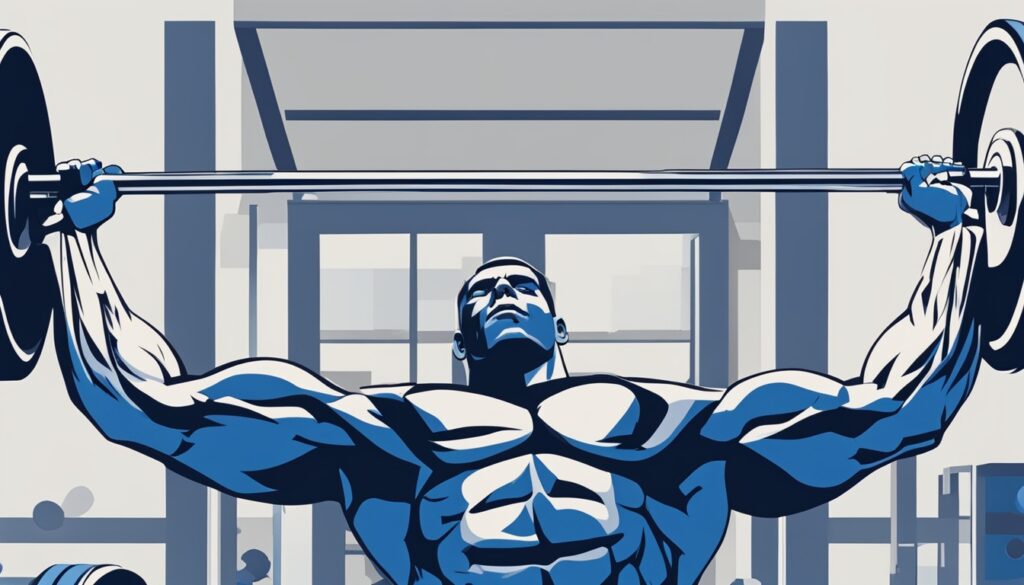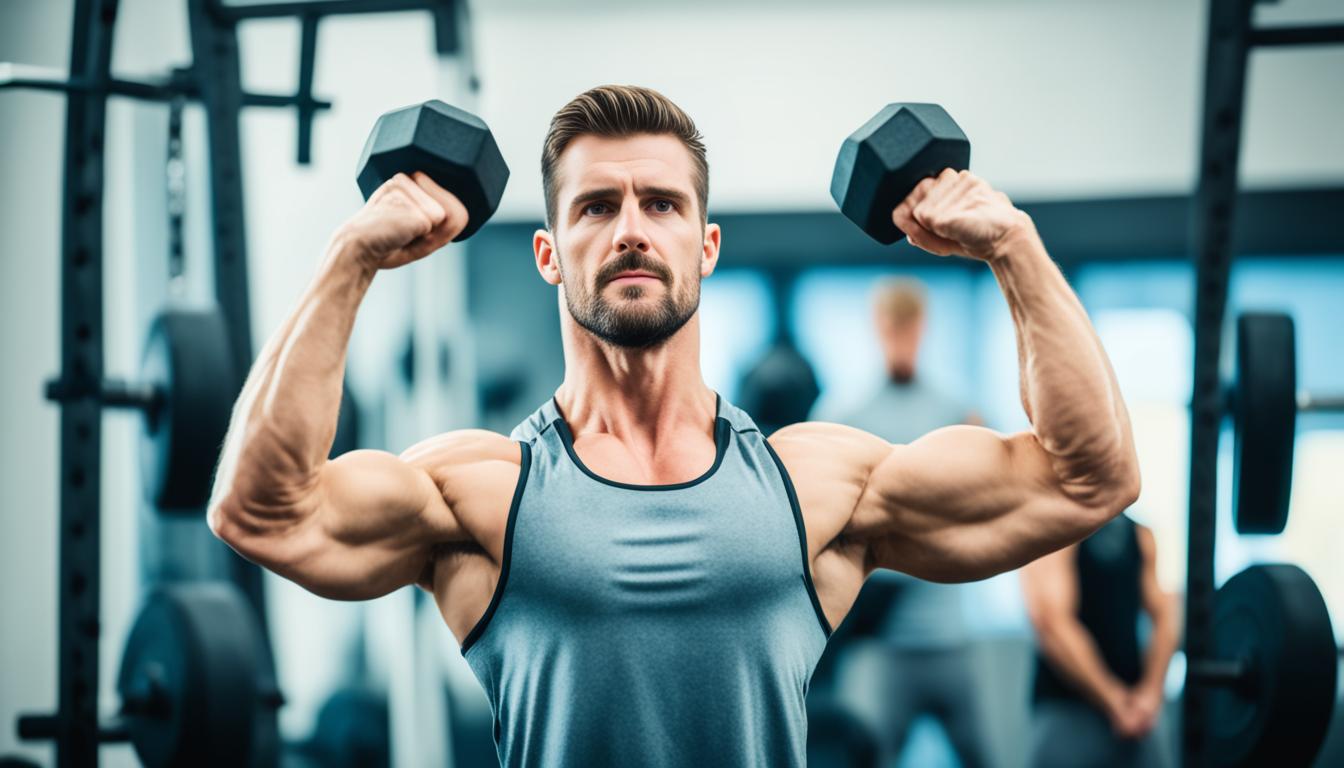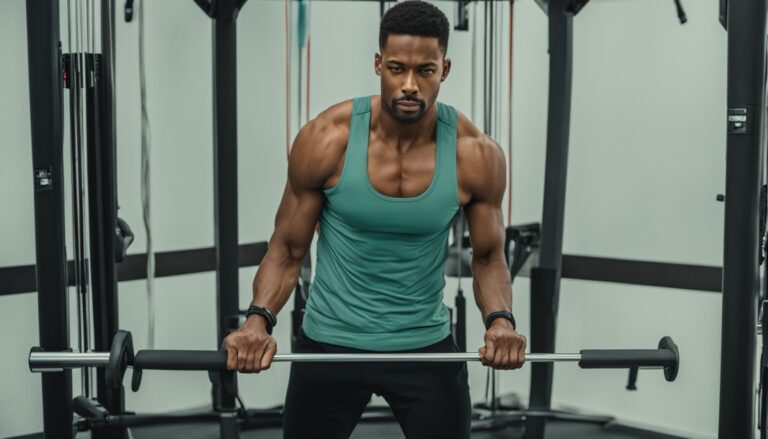As a fitness enthusiast, I’m excited to share an effective dumbbell workout routine that will help you sculpt and strengthen your shoulder muscles. Developing powerful, defined shoulders is a crucial component of building an impressive physique, and this workout will provide you with the tools to achieve that goal. Whether you’re training at the gym or working out at home, the exercises and techniques covered here will maximize your shoulder gains.
Dumbbell exercises are particularly well-suited for targeting the shoulder muscles, as they allow for greater range of motion, engage stabilizer muscles, and enable unilateral training. In this comprehensive guide, I’ll walk you through a series of dumbbell-based shoulder exercises that will challenge and stimulate your deltoids, traps, and upper back muscles.
Key Takeaways
- Dumbbell exercises are an effective way to build shoulder strength and definition.
- This workout targets all three heads of the deltoids for well-rounded shoulder development.
- Proper form and technique are crucial to avoid injury and maximize results.
- Incorporating this dumbbell shoulder routine into your fitness regimen will help you sculpt impressive, muscular shoulders.
- Consistency and progressive overload are key to continual shoulder muscle growth.
Dumbbell Workout For Shoulders: The Key to Sculpted Deltoids
When it comes to sculpting impressive shoulders, dumbbells are the ultimate tool. Unlike barbells or machines, dumbbells allow for a greater range of motion and more targeted muscle activation, making them the ideal choice for shoulder-focused workouts. In this section, we’ll explore why dumbbells reign supreme for shoulder training and dive into the key muscle groups that make up the shoulder complex.
Why Dumbbells are Ideal for Shoulder Training
The unique design of dumbbells offers several advantages for shoulder development. First, they enable independent movement of each arm, ensuring that weaker sides are not compensated for by stronger ones. This unilateral training promotes balanced muscle growth and improved stability. Additionally, the free-floating nature of dumbbells challenges your stabilizer muscles, engaging the shoulder girdle more effectively and leading to greater overall strength and definition.
The Muscles of the Shoulder Complex
- Anterior Deltoids: These front-facing deltoid heads are responsible for shoulder flexion and are crucial for exercises like the dumbbell shoulder press.
- Medial Deltoids: Targeting the side-facing deltoid heads with movements like dumbbell lateral raises is key for building broader, more pronounced shoulders.
- Posterior Deltoids: The rear deltoid heads play a vital role in shoulder extension and are activated in exercises such as reverse flyes and bent-over raises.
By incorporating a variety of dumbbell-based shoulder exercises that target all three deltoid heads, you can achieve a well-rounded, sculpted shoulder development that will transform your upper body physique.
Warm-up Routine: Preparing Your Shoulders for Action
Before diving into your dumbbell shoulder workout, it’s crucial to properly warm up your muscles. Focusing on dynamic stretches and mobility exercises designed specifically for the shoulder joint will help you prepare your body for the intense training to come. By taking a few minutes to warm up, you’ll not only enhance your shoulder exercises with dumbbells, but also reduce the risk of injury and ensure you get the most out of your workout.
Let’s explore a series of warm-up exercises that will get your shoulders ready to dominate:
- Arm Circles: Start by standing with your feet shoulder-width apart and your arms extended at your sides. Slowly make small, controlled circles with your arms, gradually increasing the size of the circles. Perform 10-15 circles forward and 10-15 circles backward.
- Shoulder Rolls: Lift your shoulders up towards your ears, then roll them back and down in a smooth, circular motion. Repeat this 10-15 times.
- Shoulder Taps: Reach your right hand across your body and tap your left shoulder, then switch sides. Complete 10-12 taps on each side to mobilize your shoulder joints.
- Bodyweight Shoulder Dislocations: Hold a resistance band or a broomstick behind your back with your hands spaced slightly wider than shoulder-width. Slowly raise the band or stick up and over your head, keeping your arms straight. Lower it back down behind your back, then repeat for 10-12 reps.
By incorporating these dynamic warm-up exercises into your routine, you’ll prepare your shoulder muscles and joints for a safe and effective dumbbell workout. Remember to listen to your body and adjust the intensity as needed to ensure a comfortable warm-up before tackling those shoulder exercises with dumbbells.
| Exercise | Sets | Reps |
|---|---|---|
| Arm Circles | 1 | 10-15 forward, 10-15 backward |
| Shoulder Rolls | 1 | 10-15 |
| Shoulder Taps | 2 | 10-12 per side |
| Bodyweight Shoulder Dislocations | 1 | 10-12 |
The Standing Dumbbell Shoulder Press
The standing dumbbell shoulder press is a powerhouse exercise that targets the entire shoulder muscle group, including the anterior, lateral, and posterior deltoids. This compound movement not only builds strong, sculpted shoulders but also engages the core, upper back, and triceps for a comprehensive upper body workout.
Proper Form and Technique
Executing the dumbbell shoulder press with proper form is crucial to maximizing the benefits and avoiding injury. Follow these steps to nail the perfect dumbbell shoulder press:
- Stand with your feet shoulder-width apart, core engaged, and dumbbells held at shoulder height with palms facing forward.
- Keeping your elbows tucked close to your body, press the dumbbells straight overhead, fully extending your arms.
- Pause briefly at the top of the movement, then slowly lower the weights back to the starting position.
- Ensure your back remains straight and your core is braced throughout the exercise.
- Avoid arching your back or swinging the weights to generate momentum.
Remember to breathe out as you press the dumbbells up and breathe in as you lower them back down. Maintaining proper form is key to targeting the dumbbell shoulder press effectively and safely.
“The dumbbell shoulder press is a versatile and effective exercise that can help you build strong, sculpted shoulders.”
Start with a weight that allows you to complete 10-12 reps with proper form, and gradually increase the load as you build strength. Incorporating the dumbbell shoulder press into your routine is a surefire way to take your shoulder development to new heights.
Dumbbell Lateral Raises: Targeting the Medial Delts
Dumbbell lateral raises are a essential exercise for sculpting the medial deltoids, which contribute to the coveted “capped” shoulder appearance that many fitness enthusiasts strive for. By properly executing this movement, you can effectively isolate and strengthen the middle portion of your deltoid muscles, leading to broader, more defined shoulders.
The key to maximizing the benefits of dumbbell lateral raises lies in maintaining proper form throughout the exercise. Start by standing with your feet shoulder-width apart, holding a dumbbell in each hand with your palms facing inward. Keeping your arms straight, raise the weights out to the sides until your arms are parallel to the ground, ensuring your elbows remain fixed in a slightly bent position. Pause briefly at the top of the movement, then slowly lower the weights back to the starting position.
To further challenge your medial delts, consider incorporating the following variations into your routine:
- Seated Dumbbell Lateral Raises: Perform the exercise while seated on a bench or stability ball to engage your core and stabilizer muscles.
- Alternating Lateral Raises: Raise one arm at a time, focusing on the contraction in the opposite shoulder.
- Bent-Knee Lateral Raises: Bend your knees slightly, which can help to better isolate the medial deltoids and reduce momentum.
Incorporating dumbbell lateral raises into your shoulder workout routine is a surefire way to sculpt and strengthen those all-important medial deltoids. Remember to maintain proper form, focus on the muscle contraction, and challenge yourself with variations to continually stimulate muscle growth and development.
| Exercise | Targeted Muscle | Benefits |
|---|---|---|
| Dumbbell Lateral Raises | Medial Deltoids |
– Builds width and capped appearance of the shoulders – Isolates and strengthens the middle portion of the deltoid muscles – Enhances overall shoulder development and definition |
Dumbbell Front Raises: Sculpting the Anterior Deltoids
Dumbbell front raises are a crucial exercise for targeting the anterior deltoids, the muscle group responsible for the “front” portion of your shoulder. By incorporating this movement into your workout routine, you can build well-rounded, sculpted shoulders that not only look impressive but also contribute to improved posture and upper body strength.
Mastering the Dumbbell Front Raise
To perform the dumbbell front raise, stand with your feet shoulder-width apart, holding a dumbbell in each hand with an overhand grip. Keeping your arms straight, raise the weights straight out in front of you until they are at eye level. Pause briefly at the top of the movement, then slowly lower the weights back to the starting position. Maintain proper form throughout the exercise, avoiding any swinging or momentum.
As you become more comfortable with the dumbbell front raise, consider implementing variations to challenge yourself and stimulate further muscle growth. One effective variation is the single-arm dumbbell front raise, which allows you to focus on each shoulder individually and promote balanced development.
- Single-Arm Dumbbell Front Raise: Hold a dumbbell in one hand and raise it straight out in front of you, keeping your arm straight. Repeat on the other side, alternating between arms for the desired number of reps.
- Bent-Knee Dumbbell Front Raise: Slightly bend your knees and hinge forward at the hips to perform the dumbbell front raise. This variation helps engage your core muscles and challenges your balance.
- Seated Dumbbell Front Raise: Sit on a bench or chair and perform the front raise, keeping your torso upright and engaged. This isolation exercise targets the anterior deltoids without the involvement of other muscle groups.
Incorporating a variety of dumbbell front raises into your shoulder workout routine can help you achieve well-rounded, sculpted deltoids and improve your overall upper body strength and appearance.
Dumbbell Shrugs: Strengthening the Traps
Dumbbell shrugs are a fundamental exercise for building bigger, stronger traps – a crucial component of well-developed shoulders. By targeting the trapezius muscles, this exercise can dramatically improve the overall appearance and strength of your upper back and shoulders.
To maximize the activation of your traps, focus on using proper dumbbell shrug technique. Start by standing upright with your feet shoulder-width apart, holding a dumbbell in each hand with your palms facing inward. Engage your core and keep your back straight as you slowly raise your shoulders towards your ears, squeezing your traps at the top of the movement. Pause briefly, then lower the weights back down in a controlled motion.
- Stand with your feet shoulder-width apart, holding a dumbbell in each hand with your palms facing inward.
- Engage your core and keep your back straight as you slowly raise your shoulders towards your ears, squeezing your traps at the top of the movement.
- Pause briefly, then lower the weights back down in a controlled motion.
Remember to focus on quality over quantity. Perform dumbbell shrugs with a full range of motion and controlled movements to ensure maximum muscle activation and growth. Experiment with different grip widths, and consider adding variation to your routine by trying cable shrugs or barbell shrugs to keep your traps guessing and continuously challenged.
“Dumbbell shrugs are a must-have exercise for anyone seeking to build bigger, stronger traps and improve the overall appearance of their upper body.”

Trap-Targeting Techniques
To further enhance the effectiveness of your dumbbell shrug routine, consider incorporating these trap-targeting techniques:
- Pause at the top of the movement to maximize muscle tension and time under tension.
- Experiment with different grip widths to target different areas of the traps.
- Add a slight forward lean to shift the emphasis to the lower traps.
- Incorporate isometric holds at the top of the movement to challenge the traps further.
By mastering the dumbbell shrug and incorporating these advanced techniques, you’ll be well on your way to building a set of powerful, well-developed traps that will not only enhance the overall aesthetic of your shoulders but also improve your posture and strength in a wide range of exercises.
The Arnold Press: A Compound Shoulder Builder
In the pursuit of sculpted shoulders, the Arnold press stands out as a powerful compound exercise that targets multiple muscle groups simultaneously. This dynamic movement, named after the legendary Arnold Schwarzenegger, engages not only the shoulder muscles but also the core and upper back, making it a highly efficient addition to any shoulder-focused workout routine.
Step-by-Step Execution
Mastering the Arnold press requires attention to detail and proper form. Here’s a step-by-step guide to executing this shoulder-building exercise with precision:
- Start by standing with your feet shoulder-width apart, holding a pair of dumbbell Arnold presses at shoulder height, palms facing inward.
- Engage your core and maintain a straight spine as you press the weights overhead, rotating your palms to face forward as you straighten your arms.
- Pause briefly at the top of the movement, then reverse the motion by lowering the weights back to the starting position, rotating your palms inward as you do so.
- Repeat for the desired number of repetitions, ensuring that your movements are controlled and deliberate throughout the exercise.
The Arnold press challenges the anterior, lateral, and posterior deltoids, as well as the upper back and core muscles, making it a comprehensive shoulder-building exercise. By incorporating this movement into your routine, you can unlock the path to sculpted, defined shoulders that command attention.
| Muscle Group | Target |
|---|---|
| Anterior Deltoids | The Arnold press places a strong emphasis on the anterior deltoids, which are responsible for shoulder flexion and arm elevation. |
| Lateral Deltoids | As the weights are pressed overhead, the lateral deltoids are engaged, contributing to the overall shoulder development. |
| Posterior Deltoids | The controlled lowering of the weights back to the starting position activates the posterior deltoids, providing a well-rounded shoulder workout. |
| Upper Back | The Arnold press also engages the upper back muscles, including the trapezius and rhomboids, which help stabilize the shoulder joint during the movement. |
| Core | To maintain proper form and balance throughout the exercise, the core muscles are engaged, promoting overall stability and strength. |
By incorporating the Arnold press into your shoulder-focused routine, you’ll be well on your way to building impressive, sculpted deltoids that turn heads.
Incorporating Shoulder Exercises in Your Routine
To maximize your shoulder development, it’s essential to incorporate these dumbbell exercises into a well-rounded workout routine. By strategically including shoulder-focused moves, you can sculpt and strengthen your upper body, leading to a more balanced and aesthetically-pleasing physique.
When structuring your shoulder workout routines, aim to train this muscle group at least 2-3 times per week. This frequency will ensure adequate stimulation and allow for proper recovery and growth. Consider dedicating a dedicated shoulder day, or integrating shoulder exercises into your existing full-body or push-pull workouts.
- Start your shoulder workouts with a thorough warm-up to prepare your joints and muscles for the upcoming exercises. Dynamic stretches and light cardio can help increase blood flow and range of motion.
- Prioritize compound exercises like the standing dumbbell shoulder press, which engage multiple muscle groups simultaneously. These movements should form the foundation of your shoulder routine.
- Complement the compound exercises with isolation movements like lateral raises and front raises to target the individual deltoid heads and achieve balanced shoulder development.
- Incorporate exercises like dumbbell shrugs to strengthen the trapezius muscles, which play a crucial role in shoulder stability and posture.
- Vary the rep ranges, sets, and load during your shoulder workouts to keep your muscles guessing and promote continued growth. A mix of heavier weights for strength and lighter weights for hypertrophy can be effective.
Remember, consistency and patience are key when it comes to building strong, sculpted shoulders. Stick to a well-structured shoulder workout routines and be mindful of your form and recovery to see long-lasting results.
“The key to building impressive shoulders is to target all three deltoid heads – anterior, medial, and posterior – with a variety of exercises.”
Nutrition and Recovery for Shoulder Development
Achieving your goals of building bigger shoulders requires more than just effective training. Proper nutrition and recovery strategies play a crucial role in supporting muscle growth and development. In this section, I’ll explore the importance of a balanced diet, the key macronutrients that fuel shoulder-building, and recommended supplements to aid in your shoulder development journey.
Fuel Your Gains with the Right Diet
A well-rounded, nutrient-dense diet is essential for building bigger shoulders. To support muscle growth, focus on consuming adequate amounts of high-quality protein, complex carbohydrates, and healthy fats. Incorporate a variety of lean proteins, whole grains, fruits, vegetables, and healthy sources of fat, such as nuts, avocados, and olive oil, into your daily meals.
Proper hydration is also crucial for muscle recovery and performance. Aim to drink plenty of water throughout the day to support your shoulder-building efforts.
Supplementation can further enhance your shoulder development. Consider incorporating whey protein, creatine, and branched-chain amino acids (BCAAs) into your routine to support muscle protein synthesis and recovery. However, always consult with a qualified healthcare professional before starting any supplement regimen.
| Macronutrient | Recommended Intake for Shoulder Development |
|---|---|
| Protein | 1.6-2.2 grams per kilogram of body weight |
| Carbohydrates | 4-7 grams per kilogram of body weight |
| Fats | 0.5-1.5 grams per kilogram of body weight |
Remember, consistency and patience are key when it comes to shoulder development. Stick to a balanced, nutrient-rich diet, and pair it with your dedicated shoulder training to see long-term results. With the right approach, you’ll be well on your way to building those coveted boulder shoulders.

“Proper nutrition and recovery are just as important as the exercises themselves when it comes to building bigger, stronger shoulders.”
Common Mistakes to Avoid During Shoulder Workouts
As a dumbbell shoulder workout enthusiast, I’ve witnessed firsthand the common pitfalls that can hinder your progress. By steering clear of these mistakes, you’ll be well on your way to sculpting the chiseled deltoids you’ve been dreaming of. Let’s dive in and explore the key areas to focus on during your shoulder training sessions.
One of the most prevalent errors I see is using momentum to swing the weights, rather than relying on controlled, deliberate movements. This can not only diminish the effectiveness of the exercises but also increase the risk of injury. Remember to keep your core engaged, move with purpose, and avoid any jerky or swinging motions during your dumbbell shoulder workout.
Another common misstep is neglecting proper form and range of motion. Maintaining correct technique is paramount, as it ensures you’re targeting the right muscle groups and avoiding unnecessary strain on your joints. Pay close attention to your body alignment, elbow positioning, and the full range of motion required for each exercise to maximize the benefits and minimize the risk of injury.
FAQ
What makes dumbbells the ideal choice for shoulder training?
Dumbbells allow for a greater range of motion and isolated muscle activation compared to barbells or machines, making them the superior choice for shoulder development. They also challenge each shoulder independently, helping to address any muscular imbalances.
What are the key muscle groups that make up the shoulder complex?
The shoulder complex consists of the anterior (front), medial (side), and posterior (rear) deltoids, as well as the trapezius muscles. Targeting and strengthening these muscle groups is crucial for building well-rounded, defined shoulders.
How should I warm up my shoulders before a dumbbell workout?
Proper warm-up is essential to prepare your shoulders for intense training. I recommend a series of dynamic stretches and mobility exercises targeting the shoulder joint and surrounding muscles to increase blood flow and improve range of motion.
Can you explain the proper form and technique for the standing dumbbell shoulder press?
The standing dumbbell shoulder press is a fundamental exercise that targets the entire shoulder muscle group. To perform it correctly, start by standing with your feet hip-width apart, holding the dumbbells at shoulder height with palms facing forward. Press the weights overhead, fully extending your arms, then slowly lower the dumbbells back to the starting position.
How do dumbbell lateral raises target the medial deltoids?
Dumbbell lateral raises are a crucial exercise for developing the medial deltoids, which contribute to the width and overall capped appearance of the shoulders. To perform this movement, stand with your feet shoulder-width apart, hold the dumbbells at your sides with palms facing inward, and raise the weights out to the sides until they’re at shoulder height.
What are some variations of the dumbbell front raise to challenge the anterior deltoids?
In addition to the traditional dumbbell front raise, you can try variations like the single-arm front raise, alternating front raise, and overhead front raise to target the anterior deltoids from different angles and keep your workouts fresh and engaging.
How do dumbbell shrugs work the trapezius muscles?
Dumbbell shrugs are a powerful exercise for building bigger, stronger traps, which are an essential component of well-developed shoulders. To perform this exercise, stand with your feet shoulder-width apart, hold the dumbbells at your sides with palms facing inward, and simply raise your shoulders up towards your ears, squeezing your traps at the top of the movement.
Can you explain the proper execution of the Arnold press?
The Arnold press is a compound exercise that engages multiple shoulder muscle groups simultaneously. Start by holding the dumbbells at shoulder height with palms facing your body. Press the weights overhead, rotating your palms to face forward as you extend your arms, then lower the weights back to the starting position.
How should I structure my shoulder workouts to maximize results?
To maximize your shoulder development, I recommend incorporating these dumbbell exercises into a well-rounded workout routine, focusing on training your shoulders 2-3 times per week. Be sure to allow for adequate rest and recovery between shoulder-focused sessions.
What dietary and recovery strategies can support shoulder growth?
Achieving your shoulder-building goals requires a balanced diet rich in the macronutrients that support muscle growth, such as protein, complex carbohydrates, and healthy fats. Supplementation with whey protein, creatine, and branched-chain amino acids (BCAAs) can also aid in recovery and muscle building. Prioritizing sleep and managing stress are also crucial for optimal shoulder development.
What are some common mistakes to avoid during dumbbell shoulder workouts?
Some common mistakes to watch out for include using too much weight and compromising form, not engaging the target muscle groups, failing to warm up properly, and neglecting rest and recovery. Maintaining proper technique and programming your shoulder workouts strategically is key to avoiding these pitfalls and maximizing your gains.







